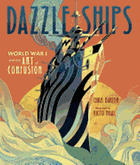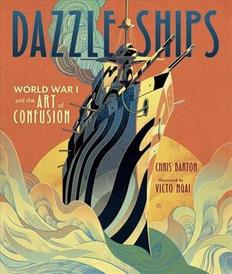
 "One of the ships on this page is painted in sneaky, stripy camouflage. You probably can't even see it. Oh. You can see it? Hmmmmmmm."
"One of the ships on this page is painted in sneaky, stripy camouflage. You probably can't even see it. Oh. You can see it? Hmmmmmmm."
The striped ship, depicted in bright blues and yellows, is a World War I Allied vessel. In 1917, the Central Powers began attacking Allied non-fighting ships; the plan was to cut off Britain and win the war by starving the island nation. Desperate to feed its people, Britain tried "different things to stop the submarine attacks": there was discussion of training seagulls and sea lions and sending swimmers to smash periscopes. Royal Naval Volunteer Reserve lieutenant-commander Norman Wilkinson was the most well-known of those who floated the idea to camouflage ships. He said, "since it was impossible to paint a ship so that she could not be seen by a submarine, the extreme opposite was the answer--to paint her, not for low visibility, but in such a way as to break up her form and thus confuse a submarine officer as to the course on which she was heading." And so the "dazzle ship" was born.
More than 3,000 U.S. and British ships were painted with the crazy-looking patterns. If the Germans were confused, their U-boats would launch torpedoes in error--the Allies hoped--and valuable resources would be wasted while Allied ships were kept safe. In both Great Britain and the United States, young female artists helped to create the designs, first on wooden models, then on paper and finally painted onto the ships themselves. In the U.S., members of the Women's Reserve Camouflage Corps "even used dazzle to draw attention to a ship-shaped New York City naval recruiting station."
Germany surrendered in November 1918 and the United States declared "that dazzle kept lots of ships from getting sunk." But "Britain wasn't so sure. The Royal Navy couldn't prove that dazzle had actually spared any ships." Effective or not, it was noted that many sailors felt safer knowing that something had at least been attempted to keep them alive. And the story of dazzle ships is a remarkable one.
As developed for children by author Chris Barton (Whoosh!), this story shows that "sometimes desperate times call for dazzling measures"; ingenuity is important, especially in the most trying of times. Paired with Barton's welcoming language and accessible story, Victo Ngai's illustrations sparkle. Using mixed analogue and digital media, she re-creates historical map templates and incorporates her own dazzle, creating overlapping and interconnecting patterns with strong lines and bright colors. Ngai's illustrations are inviting, drawing the reader in and slowing the pace of the narrative, each double-page spread an abundance of color and texture and shape, demanding time and reflection.
Dazzle Ships shines and shows that "a willingness to tackle problems by trying the unlikely, the improbable, the seemingly bonkers will always be needed." --Siân Gaetano, children's and YA editor, Shelf Awareness
Shelf Talker: Chris Barton and Victo Ngai's Dazzle Ships gives young readers an introduction to World War I in a clever and colorful way.

